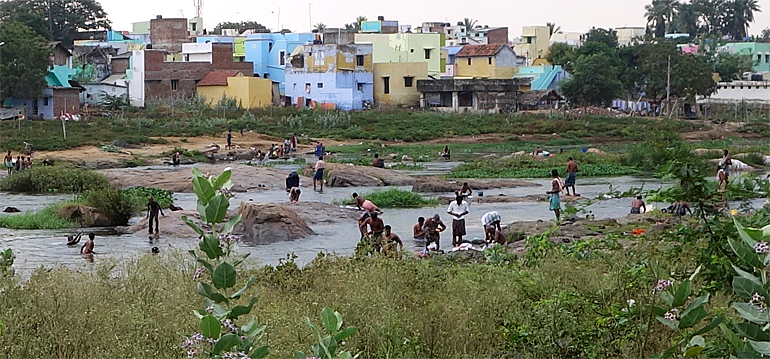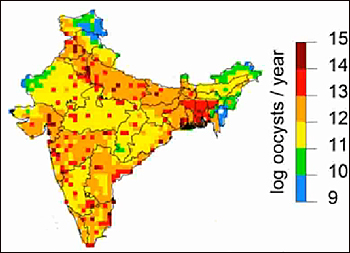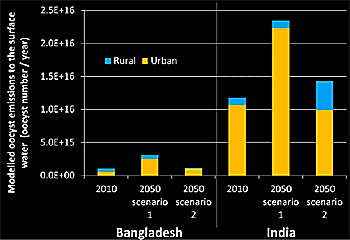New model Dutch water research institutes localises pathogens hotspots for combat against diarrhea
 KWR Watercycle research institute, Wageningen University and Delft University of Technology pooled their knowledge and developed a global model for emission and transmission of pathogenic microorganisms.
KWR Watercycle research institute, Wageningen University and Delft University of Technology pooled their knowledge and developed a global model for emission and transmission of pathogenic microorganisms.
Researchers used an initial version of the model to zoom in on India and Bangladesh and to include data on the sanitation situation in both countries. The model showed a clear relation between urban centres and emissions of Cryptosporidium.
The three institutes want to further develop the model to be able to calculate the concentration of pathogens, such as Cryptosporidium, in rivers and lakes used for drinking water, crop irrigation and recreation.
 Of all human Cryptosporidium pathogens emissions in India, 91 percent comes from urban areas (red dots).
Of all human Cryptosporidium pathogens emissions in India, 91 percent comes from urban areas (red dots).
Situation expected to deteriorate
The model indicates that at the moment in India 91 percent of total of human Cryptosporidium emissions, comes from urban areas. In Bangladesh the emissions from urban areas is 53 percent.
The model shows that the increase in parasites is causing concern. Especially if the urban centres keep growing and the living conditions with poor sanitation does not improve accordingly.
Under the 'business as usual' sanitation scenario, emissions of human Cryptosporidium will increase by a factor 2.0 for India and 2.9 for Bangladesh between 2010 and 2050.
Even the 'improved' sanitation scenario will not lead to an improvement as in India the emissions will still increase by a factor 1.2 and in Bangladesh with 1.1.
 Model calculations predict that population growth in India and Bangladesh will lead to more emissions of human Cryptosporidium and if sanitation facilities remain the same (scenario 1) the health situation will deteriorate. Even improved sanitation (scenario 2) will not reduce the emissions to surface water.
Model calculations predict that population growth in India and Bangladesh will lead to more emissions of human Cryptosporidium and if sanitation facilities remain the same (scenario 1) the health situation will deteriorate. Even improved sanitation (scenario 2) will not reduce the emissions to surface water.
Water-borne diseases
Every year around 760,000 children below the age of five die from the effects of diarrhea, making it the second biggest cause of death among children. The most common parasite, Cryptosporidium, spreads easily through drinking water, crop irrigation and swimming water where there is a lack of good sanitary facilities.
A small intake of Cryptosporidium can be sufficient for infection to take hold. Climate change, population growth and urbanisation may have a major impact on the increase in the parasite, so the chance of a diarrhea outbreak can assume life-threatening proportions.
The new model shows that tackling the problem promptly, by improving sanitary facilities and treating waste water, can save many lives in the future.
This news item was originally published on the website of KWR Watercycle research institute and Wageningen University.
More information
KWR Watercycle research institute
Nieuwegein, the Netherlands
+31 30 606 95 11
www.kwrwater.nl
Wageningen University
Environmental systems analysis group
Wageningen, the Netherlands
+31 317 484 812
www.wageningenur.nl/en



